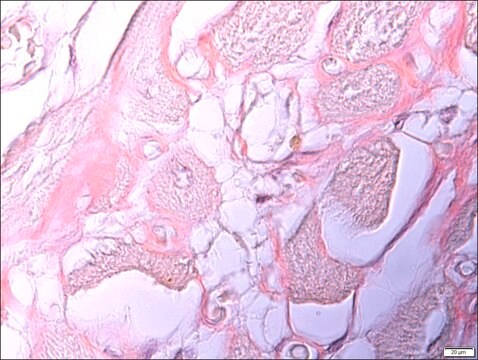C6767
Congo Red
Dye content ≥35 %, Powder
Sinonimo/i:
Congo Red 4B, Cosmos Red, Cotton Red B, Cotton Red C, Direct Red 28, Direct Red R, Direct Red Y
About This Item
Prodotti consigliati
product name
Congo Red, Dye content ≥35 %
Forma fisica
powder
Livello qualitativo
Composizione
Dye content, ≥35%
tecniche
titration: suitable
Colore
red-brown
pH
6.7 (10 g/L)
Punto di fusione
>360 °C (lit.)
Solubilità
H2O: 1 mg/mL
applicazioni
diagnostic assay manufacturing
hematology
histology
Temperatura di conservazione
room temp
Stringa SMILE
[Na+].[Na+].Nc1c(cc(c2ccccc12)S([O-])(=O)=O)\N=N\c3ccc(cc3)-c4ccc(cc4)\N=N\c5cc(c6ccccc6c5N)S([O-])(=O)=O
InChI
1S/C32H24N6O6S2.2Na/c33-31-25-7-3-1-5-23(25)29(45(39,40)41)17-27(31)37-35-21-13-9-19(10-14-21)20-11-15-22(16-12-20)36-38-28-18-30(46(42,43)44)24-6-2-4-8-26(24)32(28)34;;/h1-18H,33-34H2,(H,39,40,41)(H,42,43,44);;/q;2*+1/p-2/b37-35+,38-36+;;
IQFVPQOLBLOTPF-HKXUKFGYSA-L
Cerchi prodotti simili? Visita Guida al confronto tra prodotti
Applicazioni
- Congo red has been used as a histochemical stain for the quantification of amyloid deposits in brain tissues.
- It has been used as a cell wall inhibiting agent in fungus Cryptococcus neoformans.
- It has also been used to study microstructural details in the cell walls of raw potato and fried potato using confocal microscopy.
Azioni biochim/fisiol
Avvertenze
Danger
Indicazioni di pericolo
Consigli di prudenza
Classi di pericolo
Carc. 1B - Repr. 2
Codice della classe di stoccaggio
6.1C - Combustible acute toxic Cat.3 / toxic compounds or compounds which causing chronic effects
Classe di pericolosità dell'acqua (WGK)
WGK 3
Dispositivi di protezione individuale
Eyeshields, Gloves, type P3 (EN 143) respirator cartridges
Certificati d'analisi (COA)
Cerca il Certificati d'analisi (COA) digitando il numero di lotto/batch corrispondente. I numeri di lotto o di batch sono stampati sull'etichetta dei prodotti dopo la parola ‘Lotto’ o ‘Batch’.
Possiedi già questo prodotto?
I documenti relativi ai prodotti acquistati recentemente sono disponibili nell’Archivio dei documenti.
I clienti hanno visto anche
Il team dei nostri ricercatori vanta grande esperienza in tutte le aree della ricerca quali Life Science, scienza dei materiali, sintesi chimica, cromatografia, discipline analitiche, ecc..
Contatta l'Assistenza Tecnica.








